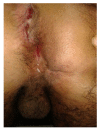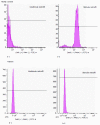Differential diagnosis in ulcerative colitis in an adolescent: Chronic granulomatous disease needs extra attention
- PMID: 28573071
- PMCID: PMC5437506
- DOI: 10.4291/wjgp.v8.i2.87
Differential diagnosis in ulcerative colitis in an adolescent: Chronic granulomatous disease needs extra attention
Abstract
Chronic granulomatous disease (CGD) is a primary immune deficiency that is commonly diagnosed under the age of 5 years (95%) and is rarely seen in adulthood. CGD may manifest as inflammatory bowel disease (IBD) in childhood. Without proper diagnosis, these patients may be monitored for years as IBD; some may even be regarded as steroid-resistant ulcerative colitis (UC) and end up having a colectomy. In this case report, we described a patient who had been followed-up for years as UC and subsequently underwent colectomy, but was finally diagnosed in adulthood as primary immune deficiency.
Keywords: Childhood; Chronic granulomatous disease; Immunodeficiency; Inflammatory bowel disease; Ulcerative colitis.
Conflict of interest statement
Conflict-of-interest statement: None to declare.
Figures






Similar articles
-
Generalized Pyoderma Gangrenosum Associated with Ulcerative Colitis: Successful Treatment with Infliximab and Azathioprine.Acta Dermatovenerol Croat. 2016 Apr;24(1):83-5. Acta Dermatovenerol Croat. 2016. PMID: 27149138
-
Severe and Rapid Progression in Very Early-Onset Chronic Granulomatous Disease-Associated Colitis.J Clin Immunol. 2015 Aug;35(6):583-8. doi: 10.1007/s10875-015-0180-2. Epub 2015 Aug 2. J Clin Immunol. 2015. PMID: 26233238
-
Ulcerative colitis associated with chronic granulomatous disease: case report.Gastroenterol Hepatol Bed Bench. 2015 Summer;8(3):233-5. Gastroenterol Hepatol Bed Bench. 2015. PMID: 26328046 Free PMC article.
-
Differentiating ulcerative colitis from Crohn disease in children and young adults: report of a working group of the North American Society for Pediatric Gastroenterology, Hepatology, and Nutrition and the Crohn's and Colitis Foundation of America.J Pediatr Gastroenterol Nutr. 2007 May;44(5):653-74. doi: 10.1097/MPG.0b013e31805563f3. J Pediatr Gastroenterol Nutr. 2007. PMID: 17460505
-
Ulcerative colitis associated enteritis: is ulcerative colitis always confined to the colon?J Clin Gastroenterol. 2004 Jan;38(1):46-51. doi: 10.1097/00004836-200401000-00011. J Clin Gastroenterol. 2004. PMID: 14679327 Review.
References
-
- Winkelstein JA, Marino MC, Johnston RB, Boyle J, Curnutte J, Gallin JI, Malech HL, Holland SM, Ochs H, Quie P, et al. Chronic granulomatous disease. Report on a national registry of 368 patients. Medicine (Baltimore) 2000;79:155–169. - PubMed
-
- Meischl C, Roos D. The molecular basis of chronic granulomatous disease. Springer Semin Immunopathol. 1998;19:417–434. - PubMed
-
- Segal BH, Leto TL, Gallin JI, Malech HL, Holland SM. Genetic, biochemical, and clinical features of chronic granulomatous disease. Medicine (Baltimore) 2000;79:170–200. - PubMed
-
- Barton LL, Moussa SL, Villar RG, Hulett RL. Gastrointestinal complications of chronic granulomatous disease: case report and literature review. Clin Pediatr (Phila) 1998;37:231–236. - PubMed
Publication types
LinkOut - more resources
Full Text Sources
Other Literature Sources

